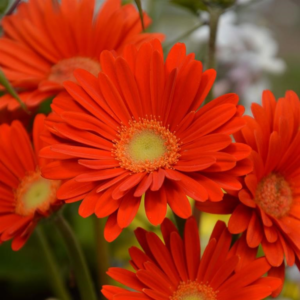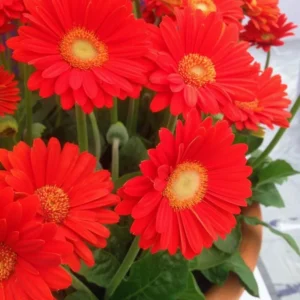If you’re on the lookout for a plant that can brighten up your garden, patio, or even your home, look no further than the Gerbera Daisy (Gerbera jamesonii). With its dazzling array of colors, including vibrant reds, pinks, yellows, and oranges, this cheerful flower is a garden favorite.
Growing Gerbera Daisy plants is a great way to bring a pop of color and happiness to your space. Gerbera Daisies are not just stunning to look at; they’re easy to care for too. But how do you make sure these colorful blooms thrive in your garden or home? You’ve come to the right place!
In this guide, we’ll walk you through everything you need to know about Gerbera Daisy care—from their ideal growing conditions to solving common problems that may arise along the way.
What Is a Gerbera Daisy?

Gerbera Daisies are native to South Africa and are known for their large, bold flowers. With blooms in nearly every color of the rainbow, including reds, oranges, yellows, pinks, and whites, these flowers are incredibly versatile and look fantastic in any setting. Gerbera Daisy care is relatively easy, and with a little attention, these plants will reward you with vibrant, long-lasting flowers.
They are perfect for adding a splash of color to your garden beds, patios, or even as cut flowers for arrangements. Growing Gerbera Daisy plants is an excellent way to enjoy these cheerful blooms, and they are also well-loved for their bright energy, making them a popular choice for anyone looking to bring a bit of happiness to their space.
Benefits of Growing Gerbera Daisies
There are countless reasons why Gerbera Daisies make a great addition to any garden or home:
Landscaping Uses
If you’re looking for a plant that can bring life to your garden or outdoor space, Gerbera Daisies are ideal. These flowers are perfect for flower beds, containers, hanging baskets, or as a border plant. Their bright, cheery blooms add an eye-catching touch to any landscape, and their compact nature means they won’t take up too much space. You can even mix and match colors to create a striking visual effect.
Growing Gerbera daisies indoors is also a great option. If you have a sunny windowsill or bright room, you can enjoy their beauty year-round. They also make excellent plants for window boxes or patio containers, bringing color and cheer wherever they are placed.
Ideal Growing Conditions for Gerbera Daisy

Here’s how you can create the perfect environment for your Gerbera Daisies to flourish:
Sunlight Requirements
One of the most important things Gerbera Daisies need is plenty of sunlight. These plants are true sun-lovers, and they’ll perform best when they get at least six hours of direct sunlight every day. The more sun they receive, the more they’ll bloom!
If you’re growing Gerbera Daisy indoors, place it near a bright, south-facing window to give it the sunlight it craves. Outdoors, you’ll want to choose a spot that gets full sun for most of the day. A sunny garden bed, patio, or balcony will be the perfect home for your Gerbera Daisy.
Temperature and Hardiness Zones
Gerbera Daisies are happiest in warm weather and thrive in temperatures between 60°F and 75°F (15°C to 24°C). They are hardy in USDA Hardiness Zones 8-11, which means they do best in areas where the temperature doesn’t fall below 20°F (-6°C).
In cooler climates, it’s best to grow Gerbera Daisies in containers so you can bring them indoors during winter to protect them from frost.
If you’re in a region with cold winters, consider growing Gerbera Daisy as an indoor plant or bringing them inside when the temperature drops. These flowers are sensitive to frost, so it’s best to err on the side of caution when the weather turns chilly.
Soil Preferences
Gerbera Daisies thrive in well-draining soil. They don’t like sitting in soggy soil, as this can lead to root rot. The best soil mix for Gerbera Daisies is a slightly acidic, well-draining mix, such as a loamy or sandy mix. Adding perlite to the soil can improve drainage and help prevent waterlogging.
If you’re growing them in containers, be sure to use a pot with drainage holes so excess water can escape. This will help maintain a healthy root system and prevent your Gerbera Daisy from getting waterlogged.
Read more: How to Prepare Soil to Plant: A Step-by-Step Guide for Beginners
How to Care for Gerbera Daisies

Watering
During the growing season (spring and summer), water your Gerbera Daisy regularly. However, it’s important to let the soil dry out slightly between waterings. Typically, watering once a week should be sufficient, but always check the soil first to see if it’s dry. In the winter months, Gerbera Daisies enter a dormant phase and require less water. You can reduce watering to once every two weeks during this time.
Signs of Overwatering or Underwatering
-
Overwatering: Yellowing leaves, mushy stems, or a wilting plant despite wet soil are signs of overwatering. If you notice any of these symptoms, it’s time to cut back on watering and allow the soil to dry out completely.
-
Underwatering: If the leaves start to curl, brown at the edges, or if the plant appears dry and wilting, it may need more water. Be sure to water deeply and ensure the soil is consistently moist but not soggy.
Fertilizing and Feeding
Gerbera Daisies do not require a lot of fertilizing, but feeding them during their growing season can help them stay healthy and produce more blooms. Use a balanced, water-soluble fertilizer, and be sure to dilute it to half-strength. Feed your plant once a month during the spring and summer. In the fall and winter, when the plant is dormant, you can stop fertilizing altogether.
Avoid over-fertilizing, as this can encourage too much leaf growth and fewer flowers. A little goes a long way, so it’s important to follow the fertilizing instructions carefully.
Pruning and Maintenance

While Gerbera Daisies don’t require heavy pruning, regular maintenance will help keep them looking their best. Remove any dead or damaged flowers to encourage new blooms and to keep your plant looking neat and tidy. Cutting back spent flowers also helps the plant conserve energy, which it can redirect toward new growth.
In addition to deadheading, you can also prune away any long or leggy stems to help shape the plant and encourage fuller growth. Pinching back the tips of the stems can help create a bushier, more compact appearance.
Common Problems and How to Fix Them
Gerbera Daisies are generally trouble-free, but like any plant, they can face some challenges. Here are some common issues and solutions:
-
Yellowing Leaves: This can be a sign of overwatering or poor drainage. Make sure the soil is drying out between waterings, and that your pot has proper drainage.
-
Pests and Diseases: Gerbera Daisies are relatively pest-resistant, but they can occasionally attract aphids or mealybugs. Wipe affected areas with a damp cloth or use insecticidal soap. If you notice fungal diseases, make sure the plant is not sitting in overly wet conditions.
-
Wilting Despite Proper Care: If your Gerbera Daisy is wilting even with the right conditions, it may be suffering from root rot. Inspect the roots and trim away any affected parts. Repot the plant in fresh, well-draining soil.
Propagating
Gerbera Daisies are easy to propagate, either by dividing the plant or taking cuttings. Spring or early summer is the best time to propagate, as the plant is in its active growth phase.
-
Offsets: If your Gerbera Daisy has side shoots (offsets), you can divide the plant and replant the offsets in new pots.
-
Stem Cuttings: To propagate via cuttings, take a healthy stem cutting and let the cut end callus over for a few days. Then, plant it in a pot with well-draining soil and water lightly.
How to Get Gerbera Daisies to Bloom

Blooming Period
Gerbera daisies typically bloom the most during the spring and fall months, offering a burst of color when the weather is mild. However, with the right care, they can bloom intermittently throughout the growing season, providing vibrant flowers for several weeks at a time.
The Gerbera daisy features a striking arrangement of colorful petals in shades of orange, red, yellow, and cream, surrounding a dark central disk. The flowers can range from 3 to 6 inches in diameter. While they are visually captivating, Gerbera daisies do not have a noticeable fragrance.
How to Encourage More Blooms?
To extend the blooming period of your Gerbera daisies and help them flower more abundantly, try these helpful tips:
- If the plant becomes too bushy, carefully remove some of the center leaves to allow more sunlight to reach the inner parts of the plant.
- Summer heat can often cause Gerbera daisies to stop blooming early, so consider moving them indoors during particularly hot spells to keep the blooms going longer.
- Feed your Gerbera daisies every two weeks with a high-phosphorus fertilizer, which is designed to encourage blooming and promote healthy flower production.
You may like:
Cape Honeysuckle Blooming Season: When to Expect Vibrant Flowers
How to Get Passionflower to Bloom: Expert Tips for Vibrant Flowers
10 Beautiful Late Spring Flowers That Bloom in May
Frequently Asked Questions (FAQs)
-
-
-
Can Gerbera Daisies grow indoors?
Yes! Gerbera Daisies can thrive indoors if placed in a bright location that receives plenty of sunlight. A south-facing window is perfect. -
How often should I water Gerbera Daisies?
Water once a week during the growing season, and once every two weeks in winter. Always check the soil to ensure it’s dry before watering. -
What’s the best soil mix for Gerbera Daisies?
Use a well-draining soil mix, such as a loamy or sandy mix. Adding perlite will help improve drainage and keep your Gerbera Daisy’s roots healthy. -
Are Gerbera Daisies safe for pets?
Yes, Gerbera Daisies are non-toxic to pets, but it’s always a good idea to keep plants out of reach of curious animals.
-
-
Conclusion
Caring for a Gerbera Daisy is a joyful and rewarding experience. With the right care, your plant will thrive, rewarding you with bright, colorful blooms that add a cheerful touch to any room or garden. So go ahead, give your Gerbera Daisy the love and attention it deserves, and watch it flourish!
Happy gardening, and don’t forget—your Gerbera Daisy will thank you for the care and attention you give it!








